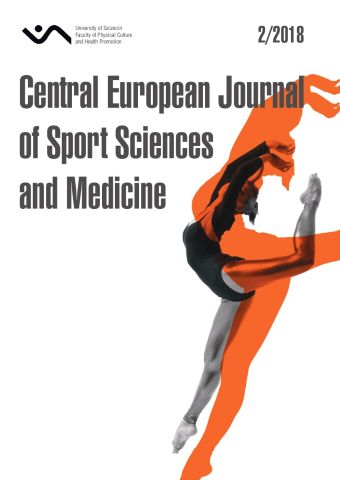
ISSN: 2300-9705
eISSN: 2353-2807
OAI
DOI: 10.18276/cej.2018.2-04




Issue archive /
Vol. 22, No. 2/2018
Test-Retest Reliability and Validity of Three Different Agility Tests for Various Team Sports in Young Male Athletes
| Authors: |
Mehmet
Kutlu

Istanbul Sabahattin Zaim University, Faculty of Health Sciencess, Department of Health Management, Istanbul, Turkey Özgür Doğan 
İstanbul Gelisim University, Exercise and Sport Science, School of Physical Education and Sport, Istanbul,Turkey |
| Keywords: | agility team sports soccer water polo basketball |
| Data publikacji całości: | 2018-06-31 |
| Page range: | 6 (33-38) |
Abstract
The purpose of this study is to examine the reproducibility of three different agility tests in basketball, soccer and water
polo team sports.
To determine the reliability 44 young male athletes (Basketball age 16.5 ±0.6, height 177.9 ±7.7 weight 70.0 ±7.1; Soccer age 16.3
±0.5, height 169.2 ±5.0, weight 71.2 ±7.9; Water Polo age 17.1 ±0.7, height 181.3 ±6.7, weight 76.7 ±7.2) performed 3 different
agility tests (Zig-Zag, Illinois and AS) on two occasions 1 wk. apart for test-retest. Sprint time scores were analyzed for each
test. To determine the reliability Paired Sample T-test and Pearson Correlation Statistics were computed. Scores of teams were
compared with ANOVA statistics to determine the difference.
Test results showed that there was no significant difference between the two occasions for all agility test on subjects and teams
(p > 0.01). There was higher correlation between test-retest values of subjects (r = 0.90–0.97). Three different agility tests were
found valid in determining agility with significant moderate level correlation. (r = 0.36–0.44; p < 0.01). Differences among sport
branches were found significant for agility scores (p < 0.05).
All three agility tests are reliable and valid for team sport athletes. Soccer players had better scores than other branches in
soccer specific test (AS). This study showed that sport specific agility tests are more useful than general agility tests.
Download file
Article file
Bibliography
| 1. | Angeli, C., Nyland, J. (2006). Training for agility and balance. Clinical decisions in therapeutic exercise. Upper Saddle River (NJ): Pearson Education, 360–361. |
| 2. | Ackland, T.R., Elliott, B., Bloomfield, J. (2009). Applied anatomy and biomechanics in sport. Human Kinetics. |
| 3. | Bloomfield, J., Ackland, T.R., Elliott, B.C. (1994). Applied Anatomy and Biomechanics in Sport. Melbourne: Blackwell Scientific Publications. |
| 4. | Castrol Edge Presents Ronaldo Tested to the Limit 2011, August 30. Retrieved from: https://sportandentertainment.mcsaatchi.com/ project/castrol-edge-presents-ronaldo-tested-to-the-limit. |
| 5. | Düking, P., Born, D.P., Sperlich, B. (2016). The Speed Court: Reliability, Usefulness, and Validity of a New Method to Determine Change-of-Direction Speed. International Journal of Sports Physiology and Performance, 11 (1), 130–134. |
| 6. | Ellis, L., Gastin, P., Lawrence, S., Savage, B., Buckeridge, A., Stapff, A., Tumilty, D., Quinn, A., Woolford, S., Young, W. (2000). Protocols for the physiological assessment of team sports players. In: C.J. Gore (ed.), Physiological tests for elite athletes (pp. 128–144). Champaign: Human Kinetics. |
| 7. | Farrow, D., Young, W., Bruce, L. (2005). The development of a test of reactive agility for netball: a new methodology. Journal of Science and Medicine in Sport, 8 (1), 52–60. |
| 8. | Kutlu, M., Yapıcı, H., Yoncalık, O., Çelik, S. (2012). Comparison of a new test for agility and skill in soccer with other agility tests. Journal of human kinetics, 33, 143–150. |
| 9. | Little, T., Williams, A.G. (2005). Specificity of acceleration, maximum speed, and agility in professional soccer players. The Journal of Strength & Conditioning Research, 19 (1), 76–78. |
| 10. | Little, T., Williams, A.G. (2007). Measures of exercise intensity during soccer training drills with professional soccer players. Journal of Strength and Conditioning Research, 21 (2), 367. |
| 11. | Pauole, K., Madole, K., Garhammer, J., Lacourse, M., Rozenek, R. (2000). Reliability and validity of the T-test as a measure of agility, leg power, and leg speed in college-aged men and women. The Journal of Strength & Conditioning Research, 14 (4), 443–450. |
| 12. | Reilly, T., Bangsbo, J., Franks, A. (2000). Anthropometric and physiological predispositions for elite soccer. Journal of sports sciences, 18 (9), 669–683. |
| 13. | Reilly, T., Williams, A.M., Nevill, A., Franks, A. (2000). A multidisciplinary approach to talent identification in soccer. Journal of sports sciences, 18 (9), 695–702. |
| 14. | Reilly, T., Williams, M. (2003). Science and Soccer. New York: Routledge USA. |
| 15. | Roozen, M. (2004). Illinois agility test. NSCA’s Performance Training Journal, 3 (5), 5–6. |
| 16. | Semenick, D. (1990). Tests and Measurements: The T-test. Strength & Conditioning Journal, 12 (1), 36–37. |
| 17. | Sheppard, J.M., Young, W.B., Doyle, T.L.A., Sheppard, T.A., Newton, R.U. (2006). An evaluation of a new test of reactive agility and its relationship to sprint speed and change of direction speed. Journal of Science and Medicine in Sport, 9 (4), 342–349. |
| 18. | Sporis, G., Jukic, I., Milanovic, L., Vucetic, V. (2010). Reliability and factorial validity of agility tests for soccer players. The Journal of Strength & Conditioning Research, 24 (3), 679–686. |
| 19. | Twist, P.W., Benicky, D. (1995). Conditioning Lateral Movements for Multisport Athletes: Practical Strength and Quickness Drills. Strength and Conditioning, 17 (6): 43–51. |